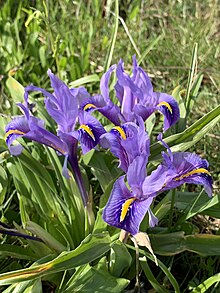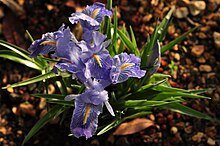fi
nimet breadcrumb-navigoinnissa


Iris planifolia ist eine Pflanzenart aus der Gattung der Schwertlilien (Iris).
Iris planifolia ist eine ausdauernde krautige Pflanzen, die Wuchshöhen von 15 bis 45 Zentimeter erreicht. Dieser Geophyt bildet Knollen, die oft unzutreffend „Zwiebeln“ genannt werden, als Überdauerungsorgane. Sie bildet fleischige Wurzeln aus. Die grundständigen Laubblätter sind 10 bis 30 Millimeter breit, nicht gleichartig zweiseitig und gewellt.
Die Blüten stehen meist einzeln, selten bis dritt. Die Blütenhüllblätter sind blau bis violett, selten weiß. Die inneren Blütenhüllblätter sind abstehend und halb so lang wie die äußeren. Die äußeren Blütenhüllblätter sind 50 bis 80 Millimeter lang und weisen in der Mitte eine papillöse, gelbe Linie auf.
Die Blütezeit reicht von November bis April.
Die Chromosomenzahl beträgt 2n = 24.[1]
Iris planifolia kommt im südlichen Mittelmeerraum vor. Auf Kreta wächst sie in Phrygana in Höhenlagen von 150 bis 600 Meter.
Iris planifolia ist eine Pflanzenart aus der Gattung der Schwertlilien (Iris).
Iris planifolia is a species of flowering plant in the subgenus Scorpiris of the genus Iris, family Iridaceae. This bulbous perennial from Southern Europe and North Africa has long, shiny green leaves, a short stem, and large scented flowers in various shades of blue.

Iris planifolia has a large brown ovoid bulb (around 2 in (51 mm) in diameter),[2] with fleshy cylindrical white roots.[3][4]
The shiny green leaves that grow up to 10–30 cm (3.9–11.8 in) long and 1–3 cm wide[4] can conceal the short stem[2] at flowering time. The leaves are lanceolate, beginning narrow at soil level and growing up to a point.[3] It is regarded as having one of the largest flowers in the subgenus Scorpiris.[5]
It can begin to flower in December,[6] in January or February.[7] In the wild it has been known to flower as late as Autumn.[8] The flowers have a light scent,[6] which can be described as spicy.[7]
It is a short, stout plant with up to three large flowers per stem,[3] which are generally 6–7 cm in diameter, with a perianth tube of 8–18 cm long. The falls are 5–8 cm long and the standards are 2 cm long.[4] The plant can reach a maximum height of 10–15 cm (3.9–5.9 in) tall.[8]
The plant has flowers in various shades of blue,[7] from bluish violet,[4] bright sky blue,[9] and lilac blue,[6] Like other irises, it has 2 pairs of petals, 3 large sepals (outer petals), known as the 'falls' and 3 inner, smaller petals (or tepals), known as the 'standards'.[6] The falls have a dark blue veining and a yellow crest on the ridge.[4][8][9] It does not have a beard.[3] Occasionally, white flowered forms can be found in the wild.[7]
The plant has tiny football shaped pollen with small spikes.[10]
The capsule is oblong, sessile, like that of Colchicum on the surface of the soil in the centre of the leaves. It has brown seeds which can be as large as a pea.[3]
The specific epithet of 'planifolia' is derived from the Greek word meaning 'with flat leaves'.[11]
It was first published by T.Durand and Schinz in 'Conspectus Floræ Africæ' No.5. in 1894.[12] But under the name Iris alata.[13]
Fiori and Paoletti in 'Flora Analytica d'Italia', recognized this species as the genus Iris from Millers original entry of Xiphium planifolium. For many years this was known under the synonym. Iris alata by Poir and recorded in a 1939 checklist.[3] Further research took then plant origin back to 1894.
Iris planifolia is now the accepted name by the RHS,[14] and it was verified by United States Department of Agriculture and the Agricultural Research Service on 4 April 2003 and the updated on 3 December 2004.[15] Note; Iris planifolia has over 20 different synonyms. See list in the infobox on the right. Iris alata (also commonly known as 'Scorpion Iris') is the most common synonym.[16]
It is native to the Mediterranean regions of Europe and North Africa.[7][15] This the only species in the Juno subgenus that can be found growing in Europe.[6]
It is found in Crete, Greece, Sicily, Spain, Portugal,[6] Sardinia,[5] (within North Africa) in Algeria, Libya, Tunisia,[15] and Morocco.[8]
White forms of the iris can be found in Andalucia.[17]
Iris planifolia is found on rocky hillsides,[5] which are generally wet in the winter and dry in the summer.

It is hardy to USDA Zone 3.[4]
The bulb is a short lived plant. It is better grown in the UK, in a bulb frame.[6] In pots or preferably in the ground.[5]
It can also be cultivated in pots.[2] But the pots need to be a minimum of 30 cm tall (or 1 ft), to allow maximum root space.[5]
It needs good ventilation to prevent disease,[3] but can be prone to virus infections.[7] Causing a loss of growth, and causes pale or streaky foliage. Infected plants should be destroyed to stop contamination of other plants.[8]
For good growth next year, it prefers a good warm dry ripening period in summer,[7] in sharply drained soil.[9]
It can be propagated naturally as it creates clumps of bulbs, that can be divided, by being very carefully teased apart in late summer. Care mus be taken not to damage the fleshy roots.[7]
Iris planifolia is a species of flowering plant in the subgenus Scorpiris of the genus Iris, family Iridaceae. This bulbous perennial from Southern Europe and North Africa has long, shiny green leaves, a short stem, and large scented flowers in various shades of blue.
Iris planifolia es una especie de la familia de las iridáceas.
Planta con bulbos de 3-5 x 2-3,5 (-4) cm, con raíces tuberosas y fistulosas y túnicas membranosas prolongadas hasta 8 (-13) cm por encima del bulbo. Tallos de hasta 3 cm, subterráneos. Hojas de hasta 30 (-35) x 3 cm, planas, plegadas, con margen denticulado, recurvas. Inflorescencia con 1-2 (-4) flores, azul-violetas o blancas. Pedicelos de 1 cm, alargándose hasta 8 cm en la fructificación. Brácteas de hasta 13 (-17) cm, membranosas, con ápice y nervios escabros. Los frutos son cápsulas de 3-5 cm oblongo-elipsoideas. Semillas de 5,5-6,5 x 4-5 mm, piriformes, rojizas. Tiene un número de cromosomas de 2n = 24, 44. Florece de diciembre a marzo.[1]
Preferentemente en suelos arcillosos. Es común en la región mediterránea, desde Portugal y Marruecos hasta Libia y Grecia.
Iris planifolia, fue descrita por (Mill.) T.Durand & Schinz y publicado en Consp. Fl. Afr. 5: 143 1894.[2]
Iris: nombre genérico llamado así por Iris la diosa griega del arco iris.[3]
planifolia: epíteto latíno que significa "con hojas planas"[4]
Iris planifolia es una especie de la familia de las iridáceas.
Iris planifolia là một loài thực vật có hoa trong họ Diên vĩ. Loài này được (Mill.) Fiori & Paol. miêu tả khoa học đầu tiên năm 1896.[1]
Iris planifolia là một loài thực vật có hoa trong họ Diên vĩ. Loài này được (Mill.) Fiori & Paol. miêu tả khoa học đầu tiên năm 1896.